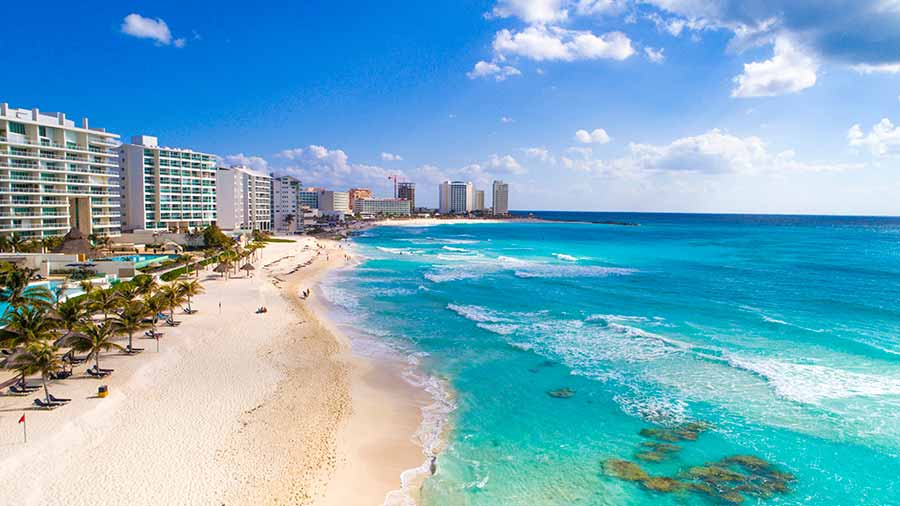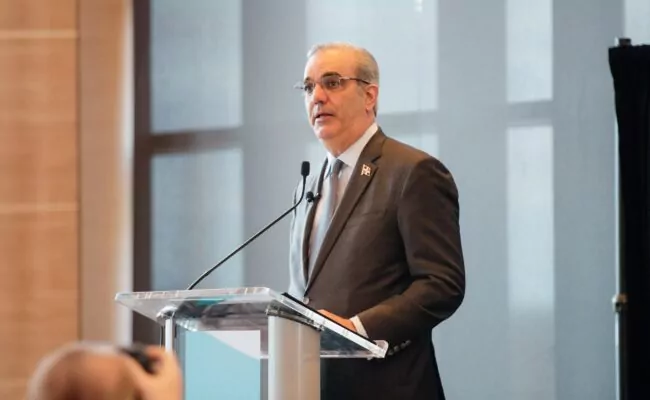México ocupa un lugar de primacía en el turismo mundial, el 8vo lugar en llegada de turistas con más de 35 millones de visitantes recibidos el año pasado, de conformidad con la Organización Mundial de Turismo(OMT), muy cerca del 6to y 7mo lugar que ocupan el Reino Unido y Alemania, respectivamente.
El turismo les produjo más de 21 mil millones de dólares en el 2017, con un gasto promedio por turista por estadía de 5,849 dólares. El Secretario de Turismo de México, Enrique de la Madrid, señalo en Enero pasado que, «el desarrollo de productos turísticos, parques recreacionales y restaurantes es necesario para seguir fortaleciendo el gasto del turista», uno de los principales índices de medición de la industria.
Los principales destinos turísticos son Cancún, Puerto Vallarta, Los Cabos, Ciudad de México y Guadalajara. Cómo podemos ver, la mayoría destinos de sol y playa con diferencias en sus productos turísticos, no solo en oferta de hoteles y restaurantes, más aún en su oferta cultural, ecoturísticas, deportiva, entre otros. México apuesta al multidestino y a la multiespecialidad.
A Cancún y Riviera Maya los visito con frecuencia anual por motivos de trabajo, al fin y al cabo, son competencia nuestra en el Caribe, el Caribe mexicano, pero no son a esos destinos a los que quiero referirme en esta oportunidad.
En Ciudad de México estuve 2 veces en 2 semanas. Pude apreciar cómo ha mejorado su oferta para el turismo de negocios y convenciones. Ciudad de México ocupa el lugar 34 a nivel mundial en ese importante segmento de la economía del turismo. Con su impresionante oferta hotelera, centro de convenciones y salones para reuniones, más su variada y exquisita gastronomía, es un lugar ideal para reuniones de negocios con la sola excepción del tránsito, que en una ciudad de 25 millones de habitantes, puede resultar un verdadero agobio.
Hice una visita al Centro Histórico, donde desde hace años fue establecido un fideicomiso para el manejo de diversos proyectos, culturales, turísticos y urbanísticos del mismo, donde se han conjugado los esfuerzos del Gobierno central, el Gobierno de la ciudad y el sector privado en sus inicios liderado por Carlos Slim, a quien pude saludar, hombre sencillo y afable, que entre otras muchas inversiones, ha puesto su colección privada de arte, numismática y otros a la disposición del público en el Museo Soumaya. Más de 2 millones de visitantes recibió el Museo el año pasado, solamente.
El Centro Histórico está dividido en cuadrantes y existe un libro que me obsequiaron que detalla la oferta histórico-cultural de cada cuadrante, en total 200 lugares de interés a visitar.
El Centro Histórico es rico en historia, cultura, arquitectura, arte, es de fácil recorrido a pie pese a su extensión, está limpio, cuidado y conservado.
No puedo más que decir que creo firmemente que vamos por el camino correcto con nuestra zona colonial de la mano del BID, que nos ha prestado una parte sustancial de los fondos para impulsar esta iniciativa del Gobierno del Presidente Medina.
El modelo del fideicomiso es un modelo a estudiar e implementar. Todos en una sola dirección, sector público, gobierno central y Alcaldía, sector privado y nuestra iglesia católica históricamente ligada a la zona colonial, una conjunción de esfuerzos en el logro de un objetivo común.
Por otra parte, visité 2 «pueblos mágicos» de México, exitosa iniciativa la designación de pueblos mágicos, tan exitosa que han tenido que «administrarla» y no dejarse llevar del entusiasmo causado por el éxito. Me refiero a Oaxaca y San Miguel de Allende, ambas ciudades declaradas por la Unesco, Patrimonio de la Humanidad.
Oaxaca y su centro histórico no es más grande que la misma zona colonial nuestra. La majestuosa iglesia de Santo Domingo de Guzmán, la Catedral, el zócalo, el mercado, sus museos, ciertamente la convierten en un pueblito encantado. Por demás, Oaxaca es considerada «cuna de sabores y texturas» en la extraordinaria oferta gastronómica de México.
San Miguel de Allende, elegida el año pasado por Travel & Leisure, como la ciudad más bella del Mundo, es una ciudad empedrada, pletórica de colores, con su extraordinaria arquitectura, patios, multiplicidad de iglesias, incluyendo la majestuosa iglesia neogótica que es el centro de la ciudad y que se vislumbra de casi cualquier parte de la misma, galerías de arte, virtualmente en todas las calles, centros de artesanía, y demás. También cuenta con bellísimos hoteles boutique, cada uno un hotel particular, muy buenos restaurantes y lo de moda, bares en el techo o Rooftop.
Convertida en lugar de retiro para muchos norteamericanos, se les ve interactuar con los locales totalmente integrados, muy lejos del conflicto creado por el Muro. Le dan ellos una nota a la escena a la cual se suman turistas japoneses, españoles, latinoamericanos y mexicanos que viajan internamente en su país en todo momento y ciertamente en Semana Santa.
Su riqueza histórica y cultural, su patrimonio religioso, y lo que es verdaderamente una agradable sorpresa, una ciudad que vive del arte y para el arte la han convertido en un referente en América Latina- Demás está decir que la ciudad está impecablemente limpia, y que la seguridad está a la vista de todos y es continua.
En fin, que como es sabido y reconocido, República Dominicana es líder en turismo en Centro América y el Caribe, y para llegar a serlo a escala mundial, pese a las limitaciones de nuestro tamaño y nuestra economía, debe ver en España y México, como nuestros referentes de éxito, países líderes mundiales en turismo, con los que mantenemos estrechos lazos históricos y económicos. Abramos los ojos, son enormes las oportunidades que Republica Dominicana tiene como país turístico.
Enrique E. De Marchena Kaluche es abogado y experto en turismo[:en]
Mexico occupies a place of supremacy in world tourism, in 8th place for tourist arrivals with more than 35 million visitors last year, according to the World Tourism Organization (WTO), a close runner up to the 6th and 7th place occupied by the UK and Germany, respectively.
Tourism produced more than 21 billion dollars in 2017, with an average cost of USD$ 5,849 per tourist per stay. The Mexican Secretary of Tourism, Enrique de la Madrid, stated that in January «the development of tourism products, recreational parks and restaurants is necessary to further strengthen tourist spending», one of the main indicators for measuring the industry.
The main tourist destinations are Cancun, Puerto Vallarta, Los Cabos, Mexico City and Guadalajara. As can we see, most are sun and beach destinations differing however in their tourism products, not only in hotels and restaurants, but also in their cultural, ecotourism and sports attractions, among others. Mexico is committed to offer multi-destination and multispecialty.
I visit Cancun and Riviera Maya each year for work reasons, after all, they are our competition in the Caribbean, the Mexican Caribbean, but these are not the destinations I’ll be referring to in this opportunity.
I was in Mexico City twice in 2 weeks. I could see how it has improved its offer for business tourism and conventions. Mexico City ranks 34th in the world in this important segment of tourism economy. With its impressive hotels offers, convention centers and meeting rooms, plus its varied and exquisite cuisine, it is an ideal place for business meetings, except for traffic, which in a city of 25 million inhabitants, it can be a real burden.
I visited the Historic Center, where a trust was set up years ago to manage various cultural, touristic and urban planning projects; a combined effort between the central government, the city government and the private sector, led initially by Carlos Slim, whom I had the pleasure of meeting, a simple and affable man, who, among many other investments, has put his private collection of art, numismatics and others items at the disposal of the public at the Soumaya Museum. The Museum received more than 2 million visitors last year alone.
The Historical Center is divided into quadrants and I was given a book detailing the historic-cultural offer of each quadrant, a total of 200 places of interest to visit.
The Historical Center is rich in history, culture, architecture, art, and despite its size, it´s easy to get around on foot, it´s clean and well kept.
I cannot help but say that I firmly believe that we are on the right track with our colonial zone in the hands of the IDB, which has lent us a substantial part of the funds to promote this initiative of President Medina´s Government.
The trust model is a model to study and implement. The public sector, central government and city council, the private sector and our Catholic Church, historically linked to the colonial zone, all rowing in one direction in joint efforts to reach a common goal.
On the other hand, I visited 2 «magical towns» in Mexico, a great initiative appointing them as magical towns, so successful that they have to «administer» them and not get carried away by the enthusiasm caused by the success. I refer to Oaxaca and San Miguel de Allende, both cities declared as World Heritage by Unesco.
Oaxaca and its historic center are no bigger than our own colonial zone. The majestic church of Santo Domingo de Guzmán, the Cathedral, the Zócalo, the market, its museums, certainly makes it an enchanting little town. In addition, Oaxaca is considered the «cradle of flavors and textures» in Mexico´s extraordinary cuisine.
San Miguel de Allende, chosen as the most beautiful city in the world last year by Travel & Leisure, is a cobbled city, full of colors, with its extraordinary architecture, courtyards, multiplicity of churches, including the majestic neo-Gothic church that is the center of the town and can be seen from almost any part of the city, art galleries, virtually on every street, craft centers, and much more. It also has beautiful boutique hotels, each one so individual, very good restaurants and Rooftop bars, now very much in trend.
It has become a place to retire for many Americans who can be seen interacting and totally at ease with the locals, far from the conflict created by the Wall. They add a note of color to the scene of Japanese, Spanish, Latin American and Mexican tourists who travel within their country all year round and particularly in Holy Week.
Its historical and cultural wealth, its religious heritage, and what is truly a pleasant surprise, a city that lives on art and for art it has become a benchmark in Latin America. Needless to say, the city is impeccably clean and security is visible at all times and its continuous.
Finally, the Dominican Republic is a known and recognized leader in tourism in Central America and the Caribbean, and to become one on a global scale, despite the limitations of our size and our economy, we must look at Spain and Mexico as references of success, leading countries in the worlds tourism, with which we have close historical and economic ties. Let’s open our eyes, the opportunities that the Dominican Republic has as a tourist country are enormous.
Enrique E. De Marchena Kaluche is a lawyer and expert in tourism.[:]




